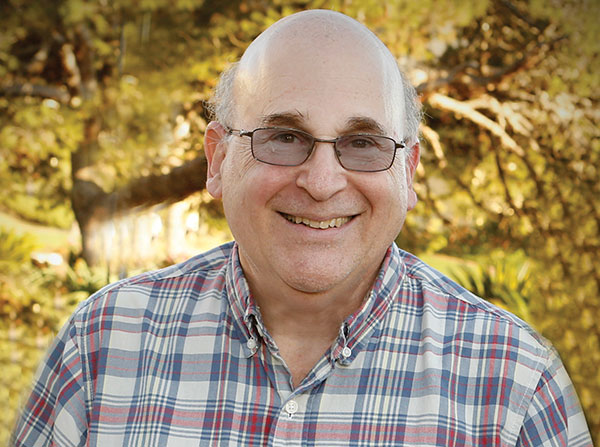
Professor Paul Aisen answers five questions on Alzheimer’s disease. (Photo/Courtesy of Paul Aisen)
The researcher explains five things to know about the only disease among the top 10 in America that cannot be prevented, cured or slowed
Scientists at the Alzheimer’s Therapeutic Research Institute (ATRI) of the Keck School of Medicine of USC have enrolled more than 1,000 people in their international clinical trials and are still seeking more participants.
Staff at the San Diego-based neurological diseases hub and their partner sites are screening thousands of people for eligibility in one of six clinical trials. They also are preparing to enroll individuals in two new studies.
Paul Aisen, director of ATRI and a professor of neurology at the Keck School of Medicine, said his team is working to accelerate progress toward finding an effective therapy for Alzheimer’s. He shares his thoughts on a disease that affects more than 5 million Americans.
Aisen will be a keynote speaker at the ninth annual International Conference on Clinical Trials for Alzheimer’s Disease, a gathering for worldwide researchers to review the most promising developments in the treatment of Alzheimer’s. The event will take place in San Diego from Dec. 8-10.
Why do you call it the ‘epidemic of Alzheimer’s’?
Alzheimer’s is the most feared consequence of aging; people are most frightened of losing themselves to a brain disorder.
For about 20 years, we’ve known that a molecular event, the accumulation of amyloid peptides in the brain, drives Alzheimer’s disease. Yet we have no effective anti-amyloid therapy for slowing down Alzheimer’s.
The disease starts 10 to 15 years before dementia. When we try to apply anti-amyloid therapies to people suffering from dementia, the end stage of Alzheimer’s disease, there already has been drastic deterioration of brain function and it may be too late to see much benefit. So even as we’ve been finding better targets for anti-amyloid treatments, we have also reframed the disease.
Alzheimer’s disease now is not considered to be a disorder that begins with the onset of dementia. It’s a disease that begins 15 or 20 years earlier. In fact, many of our efforts to control the disease include targeting amyloid before symptoms appear.
Over the last few years, for the first time, we’re bringing the most promising anti-amyloid therapies to the pre-symptomatic stage, where we think anti-amyloid therapies may be effective in dramatically changing the course of Alzheimer’s disease.
How has our approach to targeting Alzheimer’s disease changed over the years?
Thirty years ago, there were no treatments for Alzheimer’s disease and no recognition that Alzheimer’s disease would ever be treatable. There was no acceptance of the idea that memory could be treated.
Memory is a somewhat vague notion. It’s not like blood pressure that could be measured and evaluated with precision. Memory is much more subjective.
Academic investigators, however, have developed a set of tools for screening individuals for memory impairment and for measuring memory over time. Those tools, in conjunction with biostatisticians who developed analytical approaches and clinical trialists who worked out a framework for testing treatments in a new disease, led to trials that proved memory could be treated.
Can you predict who will have Alzheimer’s?
Prior to the development of amyloid PET scanning in the early 2000s, we talked only about a diagnosis of probable Alzheimer’s disease because we never knew whether the key lesion, the amyloid plaque, was present until after an autopsy examination of the brain. That’s no longer the case. Now we could talk about a definite diagnosis of Alzheimer’s disease in living people.
We believe amyloid PET scanning is the best approach to determining who will have Alzheimer’s disease. It’s one of two effective techniques. The other is using cerebral spinal fluid from a spinal tap. Either one allows us to very accurately to determine who is going to develop Alzheimer’s disease.
Why do you look for buildup of amyloid plaque in the brain before there are symptoms of Alzheimer’s?
We’ve been following people who have the signals of amyloid accumulation in brain for over a decade. We find that almost all of these individuals develop symptomatic Alzheimer’s disease. We believe this is a very accurate determination.
There is still some thought that maybe one could have amyloid without developing Alzheimer’s disease, but so far, evidence suggests that the great majority or almost everyone who has the signature of amyloid accumulation is headed for symptomatic Alzheimer’s disease over a period of five, 10, 15 years. So if individuals live for 10 or 15 years, they’re very likely to have symptomatic Alzheimer’s disease.
Why are the clinical trials studying patients who do not exhibit signs of Alzheimer’s?
We think that to beat this disease, to control Alzheimer’s disease, we have to initiate effective therapies before the symptoms really begin. Early-stage clinical trials show promising results that our treatments for controlling the accumulation of amyloid do work. But to get the benefit of these treatments, we think we have to initiate treatment before there are symptoms.
That requires a full change in paradigm for Alzheimer’s trials where we don’t select individuals on the basis of cognitive symptoms or memory impairment. We simply screen people because they’ve gotten old enough to be at risk for Alzheimer’s disease.
The sad truth is that one-third of the people over 65 have evidence of the molecular basis, the inciting stage, the abnormalities that lead to Alzheimer’s disease.
The good news is that we can identify those individuals accurately. We can take people 65 years of age and older and screen them accurately for the molecular basis of Alzheimer’s disease and we can enroll them in clinical trials. We can engage them and randomly assign them to one treatment or another, study them with effective tools and keep them in our trials. That means that we have all the tools in place to develop disease-controlling therapies for Alzheimer’s.
By Zen Vuong